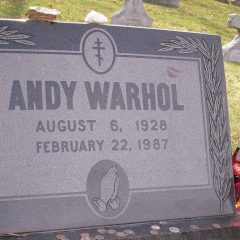Films about artists tend to focus on the unruly details of their lives, which is no great surprise, since showing them painting is about as interesting as … well, you know the old saw about watching paint dry. The Mill and the Cross is a rare film about an artist that includes neither angst, intrigue, nor sexual dalliance, although the Spanish soldiers who occupied Flanders d uring Bruegel’s day provide some rather explicit violence.
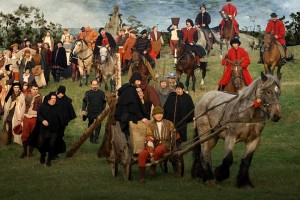
Pieter Bruegel the Elder (played by Rutger Hauer) is shown drawing the life of the villagers around him and explaining aspects of the painting he is planning to his major patron, Nicholas Jonghelinck (Michael York). The painting, The Road to Calvary, depicts various stages of Christ’s journey, and Breugel has set it in his own time and surroundings. It is the most complex work he ever painted. He points out the Roman soldiers accompanying Christ; he has dressed them in red tunics to create an obvious parallel with the Spanish troops. Like the painting, the film is filled with genre detail: children play and quarrel, a calf is dragged to market in a large basket, the miller puts flour on his tongue to test the grind, and ducks wander in and out of the artist’s house. A wind-driven mill is perched on an improbable rock outcropping and the artist tells his patron that the miller stands for God, grinding men’s lives as he surveys their activities from on high. Majewski’s artist is a thinker; his work is carefully conceived and organized and he interweaves Biblical history and current events to create a painting that works on multiple levels.
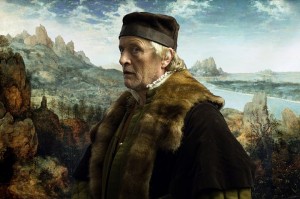
The film is suffused with Bruegel’s profound understanding that for most people, life simply goes on, despite the occurrence of events both dreadful and divine. So, within the course of a day a miller and his wife awake, a farming couple set off for market, Spanish soldiers attack the man, presumably for heresy, the artist’s wife feeds her children and kisses her infant’s stomach as she diapers him; it’s an ordinary day, when nothing much happens, the day the Savior was crucified.
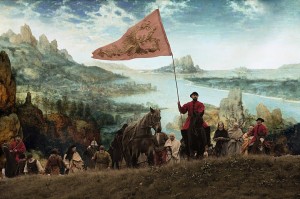
Majewski captures Bruegel’s truth that great events occur amidst the shapeless narrative of everyday life. Just as remarkable is the effect he creates of taking us into the actual space of Bruegel’s painting. His characters, in perfect period costumes (if a bit too clean) and cast with remarkable fidelity to Bruegel’s coarse-featured peasants, move in and out of the painting as landscape settings switch between filmed and painted image. While other filmmakers have recreated paintings by showing models posing (Derek Jarman in Caravaggio, Peter Weber in Girl With a Pearl Earring) the illusion of the painting itself as permeable to life is novel and startlingly effective.
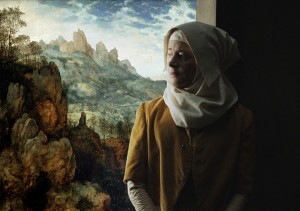
Following the painting, the film moves between Bruegel’s era and the time of the Biblical events portrayed, and not always clearly. The Virgin (Charlotte Rampling), shown as a living, breathing woman concerned for her son, inhabits the same world as the peasants of Bruegel’s day. When the question of time frame is least clear, the figure of Christ appears, although Majewski rather coyly keeps his face obscured with his hair.
Majewski is also a painter (and novelist, poet, and jack-of-all-trades in film; for The Mill and the Cross he produced, directed, edited, composed the music, co-wrote the screenplay and was co-director of photography). He obviously loves looking at paintings and this is not the first occasion in which he has organized a film around them. He wrote the screenplay to Basquiat (directed by Julian Schnabel), and the protagonist of The Garden of Earthly Delights (2004) which Majewski wrote, directed and photographed, is an art historian studying Bosch; she not only lectures about The Garden of Earthly Delights but also acts out some of its erotic incidents.
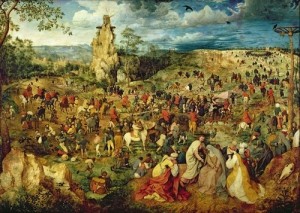
Despite the detailed attention to period details, there are a couple of small technical errors concerning the art. While it’s true that Bruegel is credited with being among the first artists to draw from life, no one would create a composition of five hundred carefully arrayed figures that way. If he used life studies, they would have been of individual figures or possibly small groups that he worked into an overall composition. And he is shown drawing with chalk, when all Breugel’s surviving drawings were done in pen and ink (usually brown).
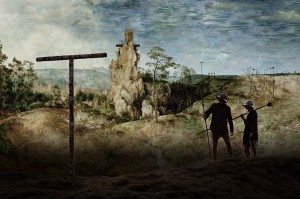
The film does not show it, but Bruegel must have been aware of his audience, since a number of his surviving drawings were intended to be engraved and Bruegel worked with the printer. His son, Pieter, made a successful business out of prints based upon his father’s work. The film gives a brief glimpse of the artist opening a portfolio to look at a group of his drawings and engravings, which later blow away in the wind.
The Mill and the Cross is based upon the book of the same title by the art historian, Michael Francis Gibson, who co-wrote the script. It premiered at the Sundance Film Festival and has been screened at the Rotterdam Film Festival and the Louvre, Paris. It opens on September 14 at Film Forum, New York.




